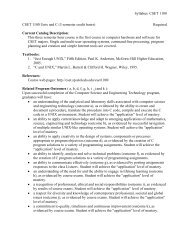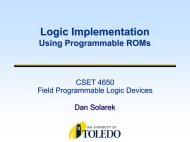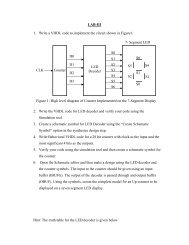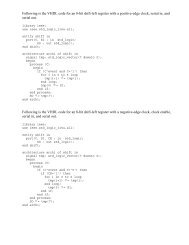Programmable Logic and Application Specific Integrated Circuits
Programmable Logic and Application Specific Integrated Circuits
Programmable Logic and Application Specific Integrated Circuits
Create successful ePaper yourself
Turn your PDF publications into a flip-book with our unique Google optimized e-Paper software.
The starting point in any logic or digital system design is a set of architectural or<br />
behavioral specifications. Traditionally, a designer uses schematic capture tools for graphical<br />
entry of a logic design which has been manually generated to meet the architectural or behavioral<br />
specifications. The upper left h<strong>and</strong> arrow in Figure 21 identifies some of the commercial CAD<br />
tools available for FPGA schematic capture. One of the more significant recent innovations in the<br />
EDA industry is the development of tools which allow the designer to move from the gate level to<br />
the behavioral level for design entry. A behavioral design specification is created using a<br />
Hardware Description Language (HDL), <strong>and</strong> then a synthesis tool automatically compiles the gate<br />
level schematic or netlist from the behavioral description. The upper right h<strong>and</strong> arrow in Figure<br />
21 indicates some of the HDLs currently being used for FPGA behavioral modeling. Section VII<br />
will present a more detailed discussion of behavioral modeling <strong>and</strong> logic synthesis.<br />
Options for behavioral description of designs include the VHSIC Hardware Description<br />
Language (VHDL), the Verilog hardware description language, timing diagrams, logic state<br />
diagrams, <strong>and</strong> PLD description languages such as ABEL. As an example of how pervasive the<br />
behavioral design style has become, the PC-based Altera MAX+PLUS II software provides<br />
multiple options for behavioral design entry. In addition to traditional schematic capture it will<br />
accept VHDL, text design description in the Altera Hardware Description Language (including<br />
truth tables <strong>and</strong> Boolean expressions), <strong>and</strong> Timing Diagrams which describe the desired input <strong>and</strong><br />
output waveforms. Whichever behavioral design entry method is chosen, the design system<br />
provides logic synthesis which automatically creates gate-level schematics.<br />
No matter what method is used for initial design entry, the next step in FPGA design is to<br />
translate the entire design into a st<strong>and</strong>ard form which can be processed by a logic optimization<br />
tool. The goal of logic optimization is to perform minimization of the Boolean expressions <strong>and</strong><br />
eliminate redundancy, thus minimizing the area of the final circuit. The tool may also be<br />
constrained to maximize speed at the expense of area by limiting the number of logic levels<br />
between clocked registers. This optimization process is usually merged with the logic synthesis<br />
step when behavioral design entry is employed. Simulation is performed both before <strong>and</strong> after the<br />
logic optimization steps to verify that the design meets the original system requirements for<br />
functionality <strong>and</strong> timing. The next step is to convert the generic gate level design into one which<br />
uses the FPGA circuit building blocks of the target technology.<br />
To provide a concrete example, the Xilinx XACT design system flow will be used to<br />
illustrate the steps needed to go from logic design to programmed FPGA. In the Xilinx design<br />
flow, the native format of the logic design (Cadence, View<strong>Logic</strong>, OrCAD, etc.) must first be<br />
translated into the Xilinx Netlist Format (XNF) which is understood by the Xilinx tools. Next, the<br />
XNF circuit description must be mapped into Xilinx Configurable <strong>Logic</strong> Blocks (CLBs). This is<br />
the technology mapping step referred to in Figure 21. Xilinx calls this step “partitioning”, <strong>and</strong> the<br />
XACT tools also attempt to optimize the circuit during this step. For example, circuitry associated<br />
with unused logic block inputs or outputs is eliminated from the design. In addition, the<br />
partitioning program attempts to minimize either the total number of CLBs used or the number of<br />
logic stages in the critical delay path.<br />
The next step is to place <strong>and</strong> route the design on the selected chip image. The XACT<br />
systems allows manual <strong>and</strong>/or automatic placement <strong>and</strong> routing. In the automatic placement<br />
34
















